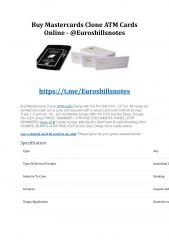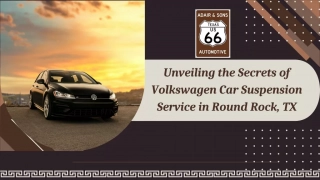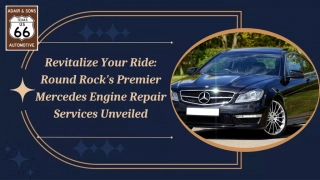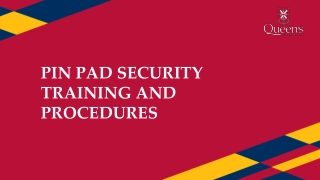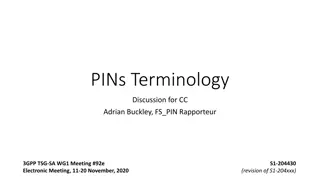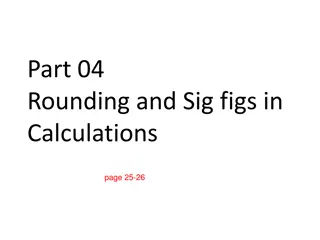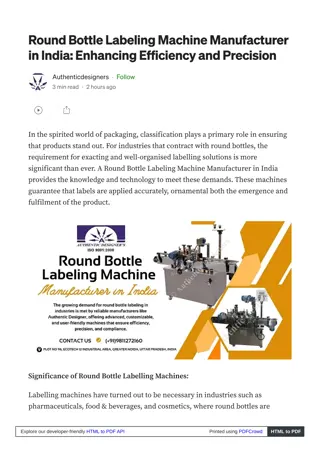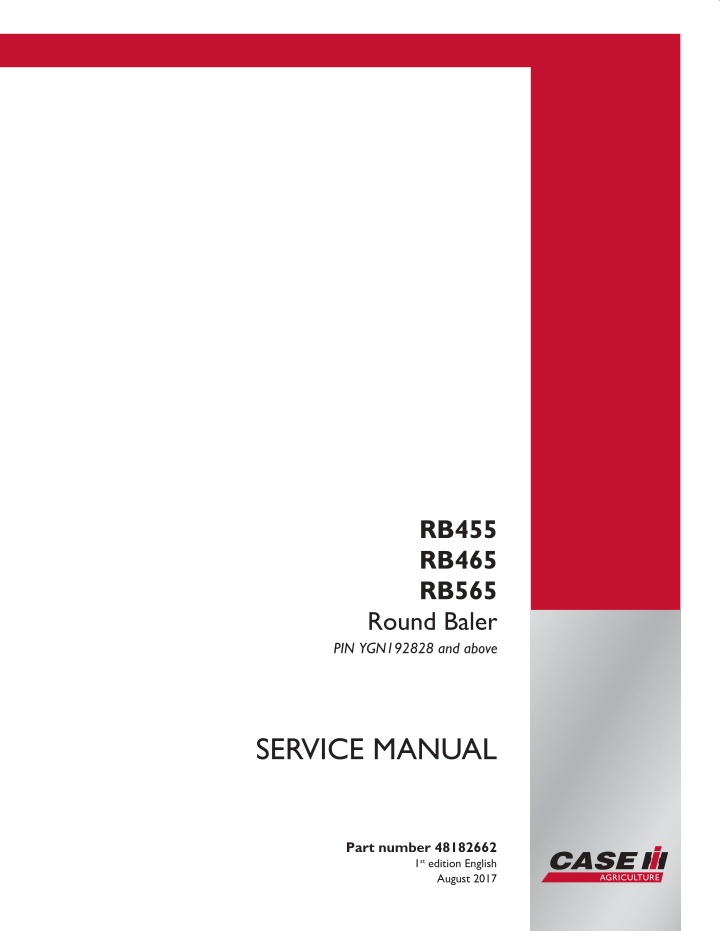
CASE IH RB465 Round Baler Service Repair Manual Instant Download (PIN YGN192828 and above)
CASE IH RB465 Round Baler Service Repair Manual Instant Download (PIN YGN192828 and above)
Download Presentation

Please find below an Image/Link to download the presentation.
The content on the website is provided AS IS for your information and personal use only. It may not be sold, licensed, or shared on other websites without obtaining consent from the author. If you encounter any issues during the download, it is possible that the publisher has removed the file from their server.
You are allowed to download the files provided on this website for personal or commercial use, subject to the condition that they are used lawfully. All files are the property of their respective owners.
The content on the website is provided AS IS for your information and personal use only. It may not be sold, licensed, or shared on other websites without obtaining consent from the author.
E N D
Presentation Transcript
RB455 RB465 RB565 Round Baler PIN YGN192828 and above SERVICE MANUAL Printed in U.S.A. Part number 48182662 1st edition English 2017 CNH Industrial America LLC. All Rights Reserved. Case IH is a trademark registered in the United States and many other countries, owned or licensed to CNH Industrial N.V., August 2017 its subsidiaries or affiliates.
SERVICE MANUAL RB455 Hay [YGN192828 - YHN195126], RB455 Hay [YHN195127 - ], RB455 Rotor Cutter [YGN192828 - YHN195126], RB455 Rotor Cutter [YHN195127 - ], RB455 Rotor Feeder [YGN192828 - YHN195126], RB455 Rotor Feeder [YHN195127 - ], RB455 Silage [YGN192828 - YHN195126], RB455 Silage [YHN195127 - ], RB465 Hay [YGN192828 - YHN195126], RB465 Hay [YHN195127 - ], RB465 Rotor Cutter [YGN192828 - YHN195126], RB465 Rotor Cutter [YHN195127 - ], RB465 Rotor Feeder [YGN192828 - YHN195126], RB465 Rotor Feeder [YHN195127 - ], RB465 Silage [YGN192828 - YHN195126], RB465 Silage [YHN195127 - ], RB565 Hay Wide Pickup [YGN192828 - YHN195126], RB565 Hay Wide Pickup [YHN195127 - ], RB565 Hay [YGN192828 - YHN195126], RB565 Hay [YHN195127 - ], RB565 Premium [YGN192828 - YHN195126], RB565 Premium [YHN195127 - ] 48182662 18/08/2017 EN
Contents INTRODUCTION Rear axle system........................................................................ 27 [27.550] Non-powered rear axle............................................................. 27.1 Power Take-Off (PTO)................................................................. 31 [31.201] Power Take-Off (PTO) drive shaft.................................................. 31.1 [31.220] Gearbox............................................................................ 31.2 [31.225] Clutches............................................................................ 31.3 Hydraulic systems....................................................................... 35 [35.000] Hydraulic systems.................................................................. 35.1 [35.540] Bale density circuit ................................................................. 35.2 [35.550] Tailgate circuit...................................................................... 35.3 [35.560] Pickup lift circuit.................................................................... 35.4 [35.568] Knife positioning circuit............................................................. 35.5 [35.569] Drop floor circuit.................................................................... 35.6 [35.570] Bale eject circuit.................................................................... 35.7 Hitches, drawbars, and implement couplings.................................. 37 [37.100] Drawbars and towing hitches ...................................................... 37.1 [37.162] Front hitch.......................................................................... 37.2 Frames and ballasting................................................................. 39 [39.100] Frame .............................................................................. 39.1 Electrical systems....................................................................... 55 [55.000] Electrical system ................................................................... 55.1 [55.100] Harnesses and connectors......................................................... 55.2 [55.404] External lighting .................................................................... 55.3 [55.422] Ejection/Unloading control system ................................................. 55.4 [55.433] Twine and net cutting and tying or wrapping....................................... 55.5 48182662 18/08/2017
https://www.ebooklibonline.com Hello dear friend! Thank you very much for reading. Enter the link into your browser. The full manual is available for immediate download. https://www.ebooklibonline.com
[55.629] Pressing/Bale formation electrical control.......................................... 55.6 [55.630] Bale density system................................................................ 55.7 [55.640] Electronic modules................................................................. 55.8 [55.DTC] FAULT CODES.................................................................... 55.9 Product feeding.......................................................................... 60 [60.220] Pickup.............................................................................. 60.1 [60.222] Wide pickup with overshot feeder.................................................. 60.2 [60.223] Wide pickup with rotor cutter or feeder............................................. 60.3 [60.260] Rotor ............................................................................... 60.4 Pressing - Bale formation............................................................. 62 [62.140] Bale formation...................................................................... 62.1 [62.141] Belt de-clutch....................................................................... 62.2 [62.150] Starter roll .......................................................................... 62.3 [62.153] Stationary roll ...................................................................... 62.4 [62.160] Floor roll............................................................................ 62.5 [62.170] Sledge.............................................................................. 62.6 Tying/Wrapping/Twisting.............................................................. 68 [68.170] Net wrapper ........................................................................ 68.1 [68.180] Twine wrapper...................................................................... 68.2 Ejection..................................................................................... 70 [70.280] Bale ejector components........................................................... 70.1 Lubrication system...................................................................... 71 [71.460] Grease lubrication system ......................................................... 71.1 [71.480] Oiler system........................................................................ 71.2 Platform, cab, bodywork, and decals............................................. 90 [90.105] Machine shields and guards ....................................................... 90.1 [90.108] Decals and plates .................................................................. 90.2 48182662 18/08/2017
INTRODUCTION 48182662 18/08/2017 1
INTRODUCTION Safety rules RB455 RB465 RB565 LA --- NA LA --- NA Personal safety This is the safety alert symbol. It is used to alert you to potential personal injury hazards. Obey all safety messages that follow this symbol to avoid possible death or injury. Throughout this manual you will find the signal words DANGER, WARNING, and CAUTION followed by special in- structions. These precautions are intended for the personal safety of you and those working with you. Read and understand all the safety messages in this manual before you operate or service the machine. DANGER indicates a hazardous situation that, if not avoided, will result in death or serious injury. WARNING indicates a hazardous situation that, if not avoided, could result in death or serious injury. CAUTION indicates a hazardous situation that, if not avoided, could result in minor or moderate injury. FAILURE TO FOLLOW DANGER, WARNING, AND CAUTION MESSAGES COULD RESULT IN DEATH OR SERIOUS INJURY. Machine safety NOTICE: Notice indicates a situation that, if not avoided, could result in machine or property damage. Throughout this manual you will find the signal word Notice followed by special instructions to prevent machine or property damage. The word Notice is used to address practices not related to personal safety. Information NOTE: Note indicates additional information that clarifies steps, procedures, or other information in this manual. Throughout this manual you will find the word Note followed by additional information about a step, procedure, or other information in the manual. The word Note is not intended to address personal safety or property damage. 48182662 18/08/2017 5
INTRODUCTION Safety rules RB455 RB465 RB565 LA --- NA LA --- NA General safety rules NOTICE:Usecautionwhenoperatingthemachineonany sloping terrain. A raised tailgate or full bale in the bale chamber will change the center of gravity of the machine. The machine can tip or roll over when near ditches, em- bankments, or uneven surfaces. 1 NHIL13RB03032AA NOTICE: High voltage power lines may require additional and significant clearance for safety due to the possibility of arcing between the power line and the baler. Pay attention to overhead power lines and hanging obsta- cles. When determining the needed clearance below obstacles and power lines, understand that when the baler is in the configuration described and shown, the distance (A), from a level ground surface to the highest point of the spare net roll storage box is 4.8 m (16 ft). Equipped with large diameter wheels and tires Equipped with a spare net roll storage box The tailgate fully raised. The bale chamber is empty. 2 NHIL13RB00846AA As the tractor driver and baler operator, never permit ride-along passengers on the tractor, in the tractor cab, or anyone to ride on the baler while being towed or operated. Never operate the machine under the influence of alcohol, drugs, or while otherwise impaired. Hydraulic oil or diesel fuel leaking under pressure can penetrate the skin, causing serious injury and infection. DO NOT use your hand to check for leaks. Use a piece of cardboard or paper. Stop engine, remove the key and relieve the pressure before connecting or disconnecting fluid lines. Make sure all components are in good condition and tighten all connections before starting the engine or pressur- izing the system. If hydraulic fluid or diesel fuel penetrates the skin, seek medical attention immediately. Continuous long term contact with hydraulic fluid may cause skin cancer. Avoid long term contact with hydraulic fluid. Wash the skin promptly with soap and water after contact with hydraulic fluid. Keep clear of moving parts. Loose clothing, jewelry, watches, long hair, and other loose or hanging items can entangle in moving parts. Wear protective equipment when appropriate. 48182662 18/08/2017 6
INTRODUCTION DO NOT attempt to remove material from any part of the machine while the machine is operating, any of the baler components are in motion, or while the tractor engine is running. Before you operate the machine, install and securely close all of the machine guards and shields. Make sure that all the guards and that all the shields are in good condition. Never operate the machine with shields open or removed. Always close the access doors and/or access panels before operating the machine. Make sure that no bystanders or pets are within the machine operating area. The machine and/or moving component on the machine can strike or crush bystanders or pets. DO NOT allow anyone to enter the work area. A raised tailgate can fall unexpectedly and crush persons underneath. Never allow anyone to enter the area under- neath a raised tailgate during operation. General maintenance safety Keep the area used for servicing the machine clean and dry. Clean up spilled fluids. Only service the machine on a firm level surface. WARNING Fall hazard! Remove wrapped crop debris from the forming rollers by clearing the bale chamber, removing belt ten- sion, and engaging the tailgate lockout valves. Remove wrapped debris from inside the bale chamber or tailgate. Do not climb on the exterior of the baler to remove wrapped debris. Failure to comply could result in death or serious injury. W0039A If you cannot reach certain areas of the machine from ground level, use a suitable ladder or other appropriate means to gain access. Do not climb on the machine for any reason. Install and close all the removed or opened guards and all the removed or open shields after servicing the machine. Close all the access doors and install all panels after servicing the machine. Do not attempt to clean, lubricate, clear obstructions, or adjust the machine while the machine operating, any of the baler components are in motion, or while the tractor engine is running. Always make sure that working area is clear of tools, parts, other persons, and pets before you start operating the machine. Always engage the tailgate lockout valve when the tailgate is open for service. A disengaged tailgate hydraulic lockout valve or unsupported hydraulic cylinders can lose pressure and drop the tailgate causing a crushing hazard. Do not leave the machine in a raised tailgate position while parked or during service, unless the tailgate is securely supported and/or the tailgate lockout valve engaged. Jack or lift the machine only at jack or lift points indicated in this operator s manual. Incorrect towing procedures can cause accidents. When towing a disabled machine follow the towing procedures in this operator s manual. Use only rigid tow bars. Stop the engine, remove the key, and relieve pressure before disconnecting or connecting fluid lines. Stop the engine and remove the key before disconnecting or connecting electrical connections. Replace damaged or worn tubes, hoses, electrical wiring, etc. Some electrical components and/or some hydraulic lines may become hot during operation. Take care when servic- ing such components. Allow the component surfaces to cool before handling the components or disconnecting hot components. Wear protective equipment when appropriate. When welding on or in close proximity to this machine, follow the instructions in this operator s manual. See Wheels and tires safety rules that follow in this chapter. 48182662 18/08/2017 7
INTRODUCTION Always disconnect the battery before welding on the machine. Always wash your hands after handling battery com- ponents. Wheels and tires You MUST completely remove the tire from the wheel or rim prior to welding the wheel or rim. DO NOT weld to a wheel or rim until you completely remove the tire from the wheel or rim. Inflated tires can generate a gas mixture with the air that can ignite from high temperatures from welding procedures performed on the wheel or rim. Deflating the tire or loosening the tire on the rim (breaking the bead) will NOT eliminate the hazard. This condition can exist whether tires are inflated or deflated. Make sure that you correctly inflate the tires within the manufacturer s specifications. Do not exceed recommended load or pressure. Follow instructions in the manual for proper tire inflation. Never inflate tires using flammable gases, as this can result in an explosion and injury to bystanders. Deflate the tire before removing any objects that are have punctured into the tire tread. Tires are heavy. Handling tires without proper equipment could cause death or serious injury. Always have a qualified tire technician service the tires and wheels. If a tire has lost all pressure, take the tire and wheel to a tire shop or your dealer for service. Explosive separation of the tire can cause serious injury. When installing wheels: 1. Install all the wheel lug hardware finger tight or slightly tighter with a socket set. 2. Torque the wheel lug hardware incrementally and in a crisscross pattern for the best equal torque distribution. Torque the wheel lug hardware to the specifications for the tire size as listed in the wheel torque table. 3. Torque the wheel lug hardware daily until the torque specification is maintained. 48182662 18/08/2017 8
INTRODUCTION Driving on public roads and general transportation safety Comply with local laws and regulations. Use appropriate lighting to meet local regulations. Make sure that the Slow-Moving Vehicle (SMV) emblem is visible. Use safety chains for trailed equipment when provided with machine or equipment. When transporting the machine on a transport trailer, make sure that you secure the machine properly for safe trans- port and that you cover the he SMV on the machine. Be aware of overhead structures or power lines and make sure the machine and/or attachments can pass safely under. Maintain complete control and machine stability by careful regulation of the travel speed at all times. Slow down and signal before turning. Pull over to allow faster traffic to pass. Follow the correct towing procedure for equipment with or without brakes. Fire and explosion prevention General safety Fuel or oil leaked or spilled on hot surfaces or electrical components can cause a fire. Crop materials, trash, debris, bird nests, or flammable material can ignite on hot surfaces. Always have a fire extinguisher on or near the machine. Make sure that you maintain and service the fire extinguisher(s) according to the manufacturer s instructions. At least once each day and at the end of the day, remove all trash and debris from the machine especially around hot components such as engine, transmission, exhaust, battery, etc. More frequent cleaning of your machine may be necessary depending on the operating environment and conditions. At least once each day, remove debris accumulation around moving components such as bearings, pulleys, belts, gears, cleaning fan, etc. More frequent cleaning of your machine may be necessary depending on the operating environment and conditions. Inspect the electrical system for loose connections or frayed insulation. Repair or replace loose or damaged parts. Do not store oily rags or other flammable material on the machine. Do not weld or flame cut any items that contain flammable material. Clean items thoroughly with nonflammable sol- vents before welding or flame-cutting. Do not expose the machine to flames, burning brush, or explosives. Promptly investigate any unusual smells or odors that may occur during operation of the machine. 48182662 18/08/2017 9
INTRODUCTION Baler specific Personal safety, prevention, and control WARNING Fire hazard! Crop materials are flammable and present a high risk of fire. Frequently remove accumulated crop or wrapping material from the machine. Inspect the machine for oil leaks and overheated bearings or other moving parts. Immediately service the machine when required; DO NOT continue to use machine until service is complete. Failure to comply could result in death or serious injury. W0392A WARNING Fire hazard! Avoid injury and/or machine damage! Do not continue to operate the machine if there is any suspected indication of roller bearing failure. Stop the machine, and check for and replace overheated and/or failed bearings. Failure to comply could result in death or serious injury. W1161A WARNING Burn hazard! Stop baling immediately if you notice a scorched odor, an unusual sound, or the sight of smoke or flames. Do not attempt to extinguish a fire that is too far advanced. Failure to comply could result in death or serious injury. W0186A Accumulated dry crop material in the baler presents a high risk of fire during operation. To minimize risk of fire: 1. Frequently check for accumulated crop material, twine, and/or net wrapping around all baler moving parts, es- pecially bearings that may be subject to overheating. Remove these flammable materials. Service overheating components immediately. 2. Attach a pressurized water fire extinguisher to the baler. If a fire occurs: 1. Eject the bale immediately. Open the baler tailgate to eject any crop material from the bale chamber, and then drive away from this material. 2. Position the tractor and baler at least 9 m (30 ft) upwind from the flames to prevent the fire from overtaking the tractor. 3. Perform the following steps only if they can be done safely: A. Open the tailgate. B. Engage the tailgate lockout valve. 4. Use a fire extinguisher to spray at the base of the flames, and/or use another water source to cool the adjacent parts. Do not position yourself under an open tailgate because the tailgate could fall if the baler is on fire. Always have a fire extinguisher easily accessible on or near the machine. A recommendation is to equip the machine with a large capacity water-type extinguisher. The water can cool hot parts to prevent a fire. In case of fire, the water will drown flames, cool hot parts, and prevent rekindling of a fire. Train all operators on the proper use of the fire extinguisher. Make sure that you maintain and service the fire extinguisher(s) according to the manufacturer s instructions. Establish a "No-Smoking" policy around the baler or when baling for operators or bystanders. Use extreme care if smoking around the baler. Stop baling immediately if noticeable changes in performance occur, or a scorched odor, an unusual sound, or the sight of smoke or flames are present. Poor performance may be indication of parts failure. Stopping immediately can limit damage done and reduce parts temperature below a point of fire ignition. Eject twine tied or net wrapped bales promptly. Do not use the baler to transport bales from the field. 48182662 18/08/2017 10
INTRODUCTION Park the baler on pavement, bare ground, or an area surrounded by bare ground. Use extreme care if necessary to park in a field of dry crop or stubble. Do not park the baler near wet baled bales due to the possible occurrence of spontaneous combustion. Do not bring a baler into a building structure or leave the baler unattended with a bale inside the bale chamber. At least once each day, immediately after baling operations, check the bearings of all the bale forming rollers for overheating, which is an indication of bearing failure. At least once each day, remove debris accumulation around moving components such as rollers, bearings, pulleys, belts, gears, cleaning fan, etc. More frequent cleaning of your machine may be necessary depending on the oper- ating environment and conditions. Crop materials, trash, debris, bird nests, or flammable material can ignite on hot surfaces. NOTICE: Avoid high pressure power-washing adjacent to the bearings to prevent damaging bearing seals. Inspect the electrical system for loose connections or frayed insulation. Repair or replace loose or damaged parts. Fuel or oil leaks, or spills on hot surfaces or electrical components can cause a fire. Do not store oily rags or other flammable material on the machine. Do not expose the machine to flames, burning brush or explosives. If service operations require using a welder, cutting torch, or grinder on the baler, follow these guidelines to prevent a fire: 1. Park the baler on pavement or bare ground. 2. Remove chaff and debris to minimize exposure of flammable material to sparks; if you cannot remove the chaff and the debris, soak the material thoroughly with water before starting service. Clean items thoroughly with nonflammable solvent before welding, flame cutting, or grinding. 3. Make sure that there is a fully charged fire extinguisher or other water source ready for immediate use. 4. Have an assistant watching for fire while welding, flame cutting, or grinding. 5. Allow parts to cool and verify that no sparks or slag has started a smoldering fire before leaving the service area and resuming baling. 48182662 18/08/2017 11
INTRODUCTION Fire extinguisher kits (Optional available from your Service Parts dealer) The fire extinguisher kit provides a means of mounting a fire extinguisher in a readily accessible location on the front right-hand side of the baler for emergency use on fires involving ordinary combustibles, such as crop mate- rial or residue, wood, cloth, and paper. Each kit installs with standard hand tools, and no drilling or welding is required. NOTE: The portable extinguisher is an extinguisher that is extremely effective, simple to use, inexpensive, and easy to recharge. The extinguisher has a 9.46 l (2.5 US gal) capacity, and uses air or nitrogen as an expellant. The cylinder and handle/lever material is of stainless steel. The valve assembly material is brass. WARNING Equipment failure could cause accident or in- jury! The supplied fire extinguisher must be ser- viced according to the instructions in this manual. Failure to comply could result in death or se- rious injury. 3 93095514 W1162A NOTICE: Failure to have the extinguisher professionally servicedmayresultintheextinguishernotoperatingprop- erly or safely as a fire fighting tool for Class A type fires. The supplied fire extinguisher is NOT charged and is NOT functional to extinguish fires until the following is com- pleted. Have the fire extinguisher inspected, serviced, charged, and maintained by a trained professional and in accordance to the requirements of local authorities hav- ing jurisdiction. 4 NHVM12RB00357AA 48182662 18/08/2017 12
INTRODUCTION General battery safety Always wear eye protection when working with batteries. Do not create sparks or have open flame near battery. Ventilate when charging or using in an enclosed area. Disconnect all connections from the battery's negative ( ) terminal first. Connect the removed battery's negative ( ) terminal connections to the battery last. When welding on the machine, disconnect both terminals of the battery. Do not weld, grind, or smoke near a battery. When using auxiliary batteries or connecting jumper cables to start the engine, use the procedure shown in the oper- ator s manual. Do not short across terminals. Follow manufacturer s instructions when storing and handling batteries. Battery post, terminals, and related accessories contain lead and lead compounds. Wash hands after handling. This is a California Proposition 65 warning. Battery acid causes burns. Batteries contain sulfuric acid. Avoid ingestion or contact with skin, eyes, or clothing. Antidotes: External contact: Flush with water. Eyes contact: Flush with water for 15 minutes and seek medical attention immediately. Internal contact: Drink large quantities of water or milk. Do not induce vomiting. Seek medical attention immediately. Keep the battery out of the reach of children and other unauthorized persons. Power Take-Off (PTO) PTO-driven machinery can cause death or serious injury. Before working on or near the PTO shaft or servicing or clearing the driven machine, put the PTO lever in the disengage position, stop the engine, and remove the key. Whenever a PTO is in operation, a guard must be in place to prevent death or injury to the operator or bystanders. When doing stationary PTO work, keep clear of all moving parts and make sure appropriate guards are in place. Never use a spline adapter: Match the right tractor PTO spline and speed with the PTO driveshaft provided with an implement. This will assure proper geometry and operating speed. Never operate 540 RPM implements at 1000 RPM. Never operate 1000 RPM implements at 540 RPM. Power Take-Off (PTO) safety booklet When you receive this baler, a Power Take-Off (PTO) safety booklet attached to the PTO shaft, provides specific PTO safety instructions. Read, understand, and keep this Power Take-Off (PTO) safety booklet for future reference. Read, understand, and keep this booklet for future reference. Reflectors and warning lights You must use flashing amber warning lights when operating on public roads, except where such use is prohibited by law. 48182662 18/08/2017 13
INTRODUCTION Personal Protective Equipment (PPE) Wear Personal Protective Equipment (PPE) such as pro- tective clothing, eye protection, hearing protection, dust mask, hard hat, heavy gloves, work boots, and/or any other PPE that provides for the safety and protection of the individual operating this equipment. 5 NHIL13RB00001AA Do Not Operate tag WARNING Risk of harm during maintenance of the machine! Before you start servicing the machine, attach a DO NOT OPERATE warning tag to the machine in a visible area. Failure to comply could result in death or serious injury. W1242A Before you start servicing the machine, attach a Do Not Operate warning tag to the machine in an area that will be visible. 1. Obtain DO NOT OPERATE tags from your CASE IH Service Parts Dealer. 2. Attach a DO NOT OPERATE tag to the machine in an area that is clearly visible whenever the machine is not operating properly and/or requires service. 3. Complete the DO NOT OPERATE tag information for the reason or maintenance hazard for the DO NOT OPER- ATE tag that you are attaching. Describe the malfunction or service required. Validate the reason for attaching the DO NOT OPERATE tag by signing your name in the designated area on the DO NOT OPERATE tag. 4. Only the person who signed and attached the DO NOT OPERATE tag should remove the DO NOT OPERATE tag, after validating the repairs or services are complete. Hazardous chemicals If exposure or contact with hazardous chemicals occurs, you may incur serious injury. The fluids, lubricants, paints, adhesives, coolant, etc. required for the function of your machine can be hazardous. They may be attractive and harmful to domestic animals as well as humans. A Material Safety Data Sheet (MSDS) provides information about the chemical substances within a product, safe handling, storage procedures, first aid measures, and procedures to take in the event of a spill or accidental release. An MSDS is available from your dealer. Before you service your machine check the MSDS for each lubricant, fluid, etc. used in this machine. This information indicates the associated risks and will help you service the machine safely. Follow the information in the MSDS, on manufacturer containers, as well as the information in this manual when servicing the machine. Dispose of all fluids, filters, and containers in an environmentally safe manner according to local laws and regulations. Check with local environmental and recycling centers or your dealer for correct disposal information. You must store fluids and filters in accordance with local laws and regulations. Use only appropriate containers for the storage of chemicals or petrochemical substances. Keep hazardous chemicals out of the reach of children or other unauthorized persons. 48182662 18/08/2017 14
INTRODUCTION Additional precautions are required for applied chemicals. Obtain complete information from the manufacturer or distributor of the chemicals before using them. Electrical storm safety Do not operate the machine during an electrical storm. If you are on the ground or operating a machine during an electrical storm: Stay away from machinery and equipment. Seek shelter in a permanent, protected structure. Remain in the cab during operation if an electrical storm strikes. Do not leave the cab or operator s platform. Do not make contact with the ground or objects outside the machine. 48182662 18/08/2017 15
INTRODUCTION Safety rules - Ecology and the environment RB455 RB465 RB565 LA --- NA LA --- NA Soil, air, and water quality is important for all industries and life in general. When legislation does not yet rule the treatment of some of the substances that advanced technology requires, sound judgment should govern the use and disposal of products of a chemical and petrochemical nature. Familiarize yourself with the relative legislation applicable to your country, and make sure that you understand this legislation. Where no legislation exists, obtain information from suppliers of oils, filters, batteries, fuels, anti-freeze, cleaning agents, etc., with regard to the effect of these substances on man and nature and how to safely store, use, and dispose of these substances. Helpful hints Avoid the use of cans or other inappropriate pressurized fuel delivery systems to fill tanks. Such delivery systems may cause considerable spillage. In general, avoid skin contact with all fuels, oils, acids, solvents, etc. Most of these products contain substances that may be harmful to your health. Modern oils contain additives. Do not burn contaminated fuels and or waste oils in ordinary heating systems. Avoid spillage when you drain fluids such as used engine coolant mixtures, engine oil, hydraulic fluid, brake fluid, etc. Do not mix drained brake fluids or fuels with lubricants. Store all drained fluids safely until you can dispose of the fluids in a proper way that complies with all local legislation and available resources. Do not allow coolant mixtures to get into the soil. Collect and dispose of coolant mixtures properly. The air-conditioning system contains gases that should not be released into the atmosphere. Consult an air-condi- tioning specialist or use a special extractor to recharge the system properly. Repair any leaks or defects in the engine cooling system or hydraulic system immediately. Do not increase the pressure in a pressurized circuit as this may lead to a component failure. Protect hoses during welding. Penetrating weld splatter may burn a hole or weaken hoses, allowing the loss of oils, coolant, etc. Battery recycling Batteries and electric accumulators contain several substances that can have a harmful effect on the environment if the batteries are not properly recycled after use. Improper disposal of batteries can contaminate the soil, groundwater, and waterways. CASE IH strongly recommends that you return all used batteries to a CASE IH dealer, who will dispose of the used batteries or recycle the used batteries properly. In some countries, this is a legal requirement. Mandatory battery recycling NOTE: The following requirements are mandatory in Brazil. Batteries are made of lead plates and a sulfuric acid solution. Because batteries contain heavy metals such as lead, CONAMA Resolution 401/2008 requires you to return all used batteries to the battery dealer when you replace any batteries. Do not dispose of batteries in your household garbage. Points of sale are obliged to: Accept the return of your used batteries Store the returned batteries in a suitable location Send the returned batteries to the battery manufacturer for recycling 48182662 18/08/2017 16
INTRODUCTION Safety rules - Machine service access RB455 RB465 RB565 LA --- NA LA --- NA WARNING Fall hazard! Remove wrapped crop debris from the forming rollers by clearing the bale chamber, removing belt tension, and engaging the tailgate lockout valve. Remove wrapped debris from inside the bale cham- ber or tailgate. Do not climb on the exterior of the baler to remove wrapped debris. Failure to comply could result in death or serious injury. W0039B Do not climb on the machine for any reason. If you cannot reach certain areas of the machine from ground level, use a suitable ladder or other appropriate means to gain access. Service the machine on a firm level surface. 48182662 18/08/2017 17
INTRODUCTION Special tools - Fabricated tools RB455 RB465 RB565 LA --- NA LA --- NA Drive chain lockup tool 1 NHIL13RB03268FA Description Item (A) (B) (C) (D) (E) Dimension 127 mm (5 in) 63.5 mm (2-1/2 in) 12.7 mm (1/2 in) 15.9 mm (5/8 in) 10.32 mm (13/32 in) Length Height Hole, distance from ends Hole, distance from side Hole, drilled, to accept a 3/8 inch x 2-1/4 inch bolt Required materials Qty 2 2 inch x 2 inch x 1/4 inch angle iron Qty 4 3/8 inch x 2-1/4 inch bolts Qty 8 3/8 inch flat washers Qty 4 3/8 inch nuts Assembly 1. Position the two angles as shown in Figure 1, and then weld them together. 2. Drill two sets of holes (E) to accept a 3/8 inch x 2-1/4 inch bolt. 48182662 18/08/2017 18
Suggest: If the above button click is invalid. Please download this document first, and then click the above link to download the complete manual. Thank you so much for reading
INTRODUCTION Drive chain lockup tool Installation The chain lock up tool is used to prevent the baler drives from rotating when checking the slip torque of the Power Take-Off (PTO) or 1.5 m wide pickup clutch. 1. Insert the chain lock up tool (1) between the chain strands. 2. Install 3/8 inch x 2-1/4 inch bolts (2) through the chain link to secure the chain strand to the lock up tool. In- stall flat washers on each side of the chain strand. 3. Secure the bolts with the 3/8 inch nuts. 2 10024757 48182662 18/08/2017 19
https://www.ebooklibonline.com Hello dear friend! Thank you very much for reading. Enter the link into your browser. The full manual is available for immediate download. https://www.ebooklibonline.com


